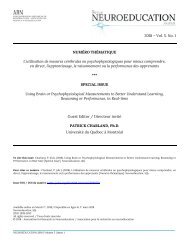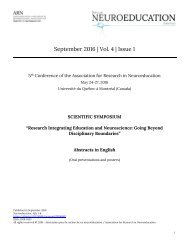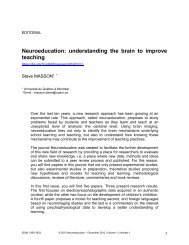Neuroeducation_2014_vol-3_no-1_full
Neuroeducation journal - Volume 3, Issue 1, 27 pages
Neuroeducation journal - Volume 3, Issue 1, 27 pages
You also want an ePaper? Increase the reach of your titles
YUMPU automatically turns print PDFs into web optimized ePapers that Google loves.
R. Babai, N. Younis, & R. Stavy Inhibitory control mechanisms in overcoming intuitive interference<br />
1. Introduction<br />
It is well k<strong>no</strong>wn that many students encounter difficulties in<br />
science and mathematics (e.g., TIMSS or PISA studies: Martin,<br />
Mullis, Foy, & Stanco, 2012; Mullis, Martin, Foy, & Arora, 2012;<br />
OECD, <strong>2014</strong>). Numerous studies have been carried out to<br />
understand students’ conceptions and reasoning. The<br />
underlying assumption is that understanding students’<br />
reasoning in science and mathematics will improve teaching<br />
in these domains.<br />
Several approaches to explain students' difficulties have been<br />
developed. One argues that incorrect responses result from<br />
lack of required cognitive schemes (e.g., Piaget & Inhelder,<br />
1974). A<strong>no</strong>ther view is that students bring alternative,<br />
internally coherent, robust, and persistent conceptions to<br />
learning situations (e.g., Driver et al., 1994; Vosniadou &<br />
Ioannides, 1998). A third approach identifies two distinct<br />
types of reasoning processes: formal/logical and intuitive<br />
(e.g., Evans & Over, 1996; Tversky & Kahneman, 1983).<br />
We believe that many students’ difficulties stem from<br />
interference of a salient irrelevant variable with<br />
formal/logical reasoning (Stavy & Tirosh, 2000). Apparently,<br />
certain variables of the task are so salient that they are<br />
automatically processed and thus interfere with correct<br />
reasoning. This interference is reflected in students’<br />
erroneous responses, even when they have the k<strong>no</strong>wledge<br />
and skills to solve these tasks correctly.<br />
Let’s consider the following examples showing interference<br />
of salient irrelevant variables in different content domains.<br />
1.2 Example from Biology<br />
Tick the correct answer.<br />
The size of a lion’s liver cell is<br />
<br />
<br />
<br />
smaller than<br />
equal to<br />
larger than<br />
the size of a cat’s liver cell?<br />
Seventy-five percent of students in Grade 8 incorrectly<br />
answered that the lion’s liver cell is larger, since the lion is<br />
“bigger” than the cat (Tirosh & Stavy, 1999). The correct<br />
response to this task is “equal to.” In fact, most cells of most<br />
organisms are approximately equal in their diameter<br />
(McMahon & Bonner, 1983). In this task, the interfering<br />
variable is the size of the animal.<br />
1.3 Example from Probability<br />
Two bags have black and white balls (see Figure 2).<br />
Bag A: 6 black balls and 4 white balls<br />
Bag B: 3 black balls and 2 white balls<br />
Which bag gives a better chance of picking a black<br />
ball?<br />
1.1 Example from Physics<br />
Two matchboxes, one <strong>full</strong> of sand and the other empty, are<br />
held at the same height (see Figure 1). They are both dropped<br />
at the same time in a vacuum. Students were asked: Will the<br />
matchboxes hit the ground at the same time? If <strong>no</strong>t, which<br />
will hit the ground first?<br />
Many students, including about 80% of first year university<br />
physics students, answered incorrectly that the heavier box<br />
would hit the ground first (Champagne, Klopfer, & Anderson,<br />
1979). According to physics laws, the two boxes will hit the<br />
ground at the same time. In this task, the interfering variable<br />
is the weight of the boxes.<br />
<br />
<br />
<br />
Same chance<br />
Bag A<br />
Bag B<br />
Figure 2. Probability task.<br />
Figure 1. Free fall task.<br />
In Green’s (1983) study, about 50% of adolescents incorrectly<br />
answered that Bag A gives a better chance of picking a black<br />
ball, since “it contains more black balls.” The correct response<br />
to this task is “same chance,” as the ratios of number of black<br />
balls to number of white balls in each box are equal. In this<br />
task, the interfering variable is the number of black balls.<br />
NEUROEDUCATION <strong>2014</strong> | Volume 3 | Number 1 2








